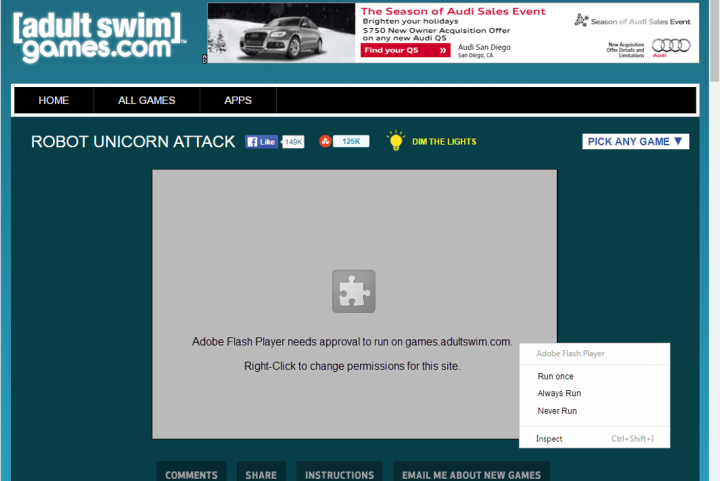
The death of Adobe’s Flash became inevitable in 2011, when plans for a mobile version were completely abandoned. Since then, any site that uses Flash has to include an alternative for mobile users, who increasingly make up the bulk of web traffic. Meanwhile, on the desktop, Flash’s well-documented security problems persist, endangering users and prompting constant update notifications.
Last year Chrome started automatically pausing non-critical Flash files — mostly advertisements — in an attempt to reduce CPU and energy usage. Upcoming changes, outlined in a mock-up titled HTML5 by default, show how Chrome might handle this. To quote the bullet points:
- Flash Player will come bundled with Chrome, however its presence will not be advertised by default.
- If a site offers an HTML5 experience, this change will make that the default experience.
- When a user encounters a site that needs Flash Player, a prompt will appear at the top of the page, giving the user the option of allowing it for a site.
- If the user accepts, Chrome will advertise the presence of Flash Player, and refresh the page.
- Chrome will honor the user’s setting for that domain on subsequent visits.
- To avoid over-prompting users, we will initially ship with a whitelist of the then top 10 sites (based on aggregate usage). This whitelist will expire after one year.
The specifics of this workflow aren’t finalized, meaning the exact wording and look of the interface may change. And whitelisting the top 10 sites for a year should reduce the impact on users without exposing too many security vulnerabilities. But this is happening: The top browser in the PC market is going to block Flash by default.
The change means websites that don’t switch to, or at least offer, an HTML5 alternative to any Flash-based UI elements are going to have a pretty ugly site by default, with large grey boxes replacing content. If that doesn’t encourage web developers to replace Flash, we’re not sure what will.
This is far from Google’s first anti-Flash move. YouTube switched to HTML5 by default last year, and Google’s ads division automatically converts ads to HTML5. In 2017, Google won’t allow Flash-based ads on its network, meaning the decision to block Flash on Chrome won’t affect Google’s bottom line.
Flash probably won’t die completely for a long time yet, meaning this little proprietary technology is surviving despite an onslaught from Google, Apple, and several other big technology companies.
Editors' Recommendations
- 5 web browsers you should use instead of Google Chrome or Edge
- Google may build Gemini AI directly into Chrome
- Google just settled a $5B privacy suit involving Chrome browser
- Google has a great idea to fix your tab chaos in Chrome
- I found a Chrome extension that makes web browsing bearable again


